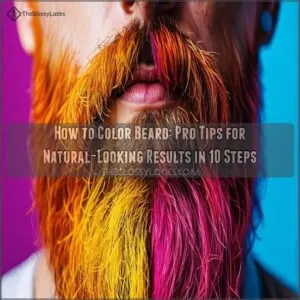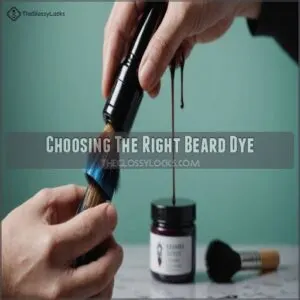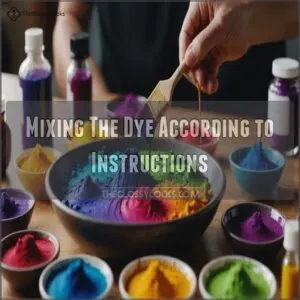This site is supported by our readers. We may earn a commission, at no cost to you, if you purchase through links.
 Coloring your beard is just like giving a trusty friend a new look.
Coloring your beard is just like giving a trusty friend a new look.
First, pick a beard dye that matches your hair and skin tone. Do a patch test—better safe than sorry!
Clean and comb your beard to prep it for the big change. Follow the dye’s instructions like you’re baking your grandma’s secret cake recipe, and don’t forget the timer.
Once your beard’s transformed, rinse thoroughly and condition for that soft finish. Want longevity? Maintenance is key; a bit of beard oil goes a long way. Keep reading for tips on achieving the most natural-looking results possible.
Table Of Contents
- Key Takeaways
- Choosing The Right Beard Dye
- Preparing Your Beard for Dye
- The Beard Dyeing Process
- Maintaining and Removing Beard Dye
- Natural Alternatives to Dyeing Your Beard
- Selecting The Best Beard Dye for You
- Common Mistakes to Avoid When Dyeing Your Beard
- How to Achieve a Natural-Looking Beard Color
- Tips for Dyeing Your Beard at Home
- Aftercare and Follow-Up for Your Dyed Beard
- Frequently Asked Questions (FAQs)
- How to dye a beard?
- What color beard dye should I use?
- How do I choose a beard color?
- How do I choose the best beard dye job?
- What is the proper way to dye your beard?
- Can you use hair dye on a beard?
- How can I color my beard naturally?
- Should men dye their beard?
- How often should I dye my beard?
- Will beard dye affect skin underneath?
- Can I dye a very short beard?
- Does beard dye work on all hair types?
- How to choose between temporary and permanent dye?
- Conclusion
Key Takeaways
- Choose a beard dye that matches your skin tone and hair color to achieve a natural look, especially considering the challenges of dyeing red hair, such as achieving the right tone with blonde dye on red hair.
- Prepare your beard by cleaning and conditioning it before applying the dye to ensure even coverage.
- Always perform a patch test to avoid allergic reactions and irritation.
- Use beard oil and balm post-dye for softness and color maintenance, and schedule regular touch-ups.
Choosing The Right Beard Dye
Picking the right beard dye is like choosing the perfect hat—it’s gotta match your style and complexion.
You’ll want to think about your skin tone, natural hair color, and whether you’re after a temporary touch-up or a long-term transformation.
Understanding Skin Tone and Hair Color
To find your ideal hair color based on skin tone and consider a matching beard dye, take the ‘What Color Suits Me?‘ quiz for personalized recommendations. Choosing the right beard dye depends heavily on your skin tone and hair color. When selecting a dye, consider the potential risks of hair dye sensitivity and allergies.
You’ll want to pick a shade that complements your natural look, not one that screams "I dyed my beard!"
Here’s a quick guide to nailing that perfect match:
- Analyze your skin undertones (cool, warm, or neutral)
- Consider your natural hair color and desired outcome
- Test shades on a small patch before committing
- Factor in your lifestyle and maintenance preferences
Remember, the goal is to enhance your rugged charm, not become a beard-dyeing cautionary tale!
Temporary or Permanent Dye
So, you’ve matched your skin tone.
Now, let’s talk commitment level.
Temporary dyes are like a fling – they wash out fast but are great for experimenting.
Perfect for commitment-phobes or quick touch-ups.
If you’re looking for some options, check out the best beard dyes for sensitive skin.
Permanent dyes? They’re the long-term relationship of beard coloring.
They last longer and offer more color options, but watch out for potential damage.
Choose wisely, fellas – your beard’s future depends on it!
Considering Desired Outcome
Picturing your ideal beard color is important. Think about your skin tone, hair color, and personal style.
Want a subtle change? Go for a shade close to your natural color. Feeling bold? Try a trendy hue that complements your facial features.
Consider your beard style too – a fuller beard might look great with a darker shade. Remember, your desired outcome guides your choice between permanent and temporary dyes.
Let’s make your beard goals a reality!
Preparing Your Beard for Dye
You’re about to turn your beard into a work of art, but first, let’s get it ready for its color makeover.
Think of it as prepping a canvas – you’ll want to clean, condition, and test for any surprise reactions before you release your inner beard artist.
Assessing Beard Health
Now that you’ve got your dye, let’s talk beard health.
Before you start coloring, give your facial hair a once-over. Look out for beard split ends, dryness, or breakage – these are red flags.
If you’re dealing with itchiness or frizz, your beard might need some TLC first.
A healthy beard takes dye better, so pamper it with some beard oil or conditioner.
Your facial hair will thank you, and you’ll rock that new color like a pro!
Patch Testing for Allergic Reactions
Before you transform your beard, let’s play it safe.
Your skin’s as unique as you are, so a patch test is your best friend.
Dab a tiny bit of dye behind your ear or on your inner elbow. Wait 48 hours and watch for any redness, itching, or swelling.
It’s like a mini dress rehearsal for your skin. No reaction? You’re good to go, champ!
Cleansing The Beard With Shampoo
Time to get your beard squeaky clean!
To maintain a healthy beard, consider a gentle, sulfate-free beard wash and cleansing routine. Grab a beard-specific shampoo to maintain your facial hair’s natural pH balance.
Wet your beard thoroughly, then work in a dime-sized amount of shampoo. Massage it gently into your skin and beard, paying extra attention to those hard-to-reach spots.
Rinse thoroughly with lukewarm water until the water runs clear. For sensitive skin, opt for a mild, fragrance-free formula to avoid irritation before dyeing.
Softening The Beard With Conditioner
With your beard squeaky clean, it’s time to soften it up for the dye.
Think of your beard as a sponge – the softer it is, the better it’ll soak up that color.
Grab your favorite conditioner and work it through your beard like you’re petting a fluffy cat.
This step’s a game-changer for a smooth, even dye job.
- Use a beard-specific conditioner for best results
- Massage the conditioner from roots to tips
- Let it sit for 3-5 minutes to really soak in
- Rinse with cool water to seal in moisture
- Follow up with a lightweight beard oil for extra softness
The Beard Dyeing Process
You’re about to transform your beard from drab to fab!
Get ready to mix, brush, wait, and rinse your way to a dapper new look that’ll turn heads faster than you can say "beard dye.
Mixing The Dye According to Instructions
Mixing beard dye feels like a science experiment, but don’t worry—it’s easy!
Grab your beard dye kit and follow those beard dye instructions to a tee.
Nail the perfect dye ratio for rich color depth and smooth consistency.
Keep an eye on the mixing time to make sure dye safety is maintained.
Voilà, you’re ready to transform your beard color effortlessly!
Applying The Dye With a Brush or Gloves
Now that your dye’s mixed, let’s get it on!
A brush offers precise dye application for even coverage, especially around tricky areas.
Gloves protect your hands from staining, but a brush might give you better control.
Consider your beard’s thickness; a brush works best for denser beards.
Remember, practice makes perfect!
Applying beard dye is like painting a masterpiece – take your time, and you’ll achieve a fantastic beard color.
Leaving The Dye on for The Recommended Time
You’ve brushed on your dye; what’s next in the beard dyeing process?
Set a timer!
Leaving the beard dye on for the recommended time is like baking a cake—over-dyeing makes it crumble, and under-dyeing leaves it raw.
Product variation affects dyeing time, so follow the instructions to nail that perfect beard color intensity.
Skip this step, and it’s gray hair central!
Rinsing The Beard Thoroughly
Imagine this: you’ve nailed the dyeing a beard phase, and it’s time to rinse. Grab water—not hot, not cold. Perfect temperature is key to prevent color bleeding, and don’t forget to apply a thick moisturizing cream or oil around the hairline to prevent staining and protect sensitive skin, as you’d when learning how to dye beard without staining skin.
Here’s your checklist:
- Rinsing technique: Be gentle.
- Rinsing time: Until water runs clear.
- Dye removal: No stubborn patches.
- Beard color: Vibrant and even.
Rinse right for radiant results!
Maintaining and Removing Beard Dye
Keeping your beard color fresh and vibrant is like maintaining a new car—regular care is key, but sometimes you need to trade in for a fresh coat of paint.
Use beard oil to tame and soften those rebellious hairs,
and when it’s time for a little gray sneak attack, grab your favorite touch-up dye for a quick fix.
Using Beard Oil for Softening
After mastering the dyeing process, you’ll want your beard to feel as great as it looks.
Beard oil is your best friend here.
Apply it regularly to keep your beard soft and manageable, and consider using a high-quality beard dye product to achieve the best results.
It not only enhances beard styling but also nourishes and maintains your dye, offering benefits like reduced dryness.
Choose oils suited for your beard type.
Touching Up Gray Hair
As you smooth your beard with oil, think about touch-ups for those stubborn gray hairs, and remember to opt for a shade slightly lighter than your desired color for a more natural look.
Embrace regular routines for beard touch-ups to keep things looking fresh.
Selecting a long-lasting beard dye helps maintain the color longer, but keep a sharp eye on touch-up frequency.
Natural remedies like henna or black tea can gently nudge gray strands back into line.
Natural Alternatives to Dyeing Your Beard
Why not give your beard a splash of nature using items you might already have in your kitchen, like coffee or beet juice?
These natural alternatives to traditional dyes offer a fun and less chemically intense way to keep your beard looking fresh and vibrant.
Using Henna, Indigo, and Other Natural Ingredients
Ready to ditch the chemicals? Henna and indigo are your natural beard dye heroes! Henna gives reddish-brown hues, while indigo adds depth and darkness.
A Henna vs. Indigo comparison shows indigo’s better for covering gray.
Find a DIY recipe online – it’s easier than you think!
Check a color chart before you start.
Remember, natural dyes may require multiple applications for long-term results.
Embrace the earthy beard color!
Beet Juice, Carrot Juice, and Coffee as Dye Alternatives
Imagine sipping a morning brew and suddenly—light bulb moment—you’re dyeing your beard with coffee!
This DIY solution could turn your face fuzz into a charming shade.
Want to dabble with beet juice or carrot juice?
Here’s a quick list to start:
- Brew strong coffee.
- Mix beet or carrot juice.
- Apply to beard.
- Rinse after 30 minutes.
Cinnamon, Sage, and Black Tea for Natural Coloring
Tired of chemicals?
Cinnamon, sage, and black tea offer a natural twist to the beard dyeing process.
Steep these ingredients, create a paste, and apply to your beard.
If you prefer to use commercial products, you can explore beard dye products as an alternative.
This natural dye recipe adds a rich hue but also cares for hair health.
Just remember, results may vary!
Always test a small patch to avoid surprises.
Happy coloring!
Selecting The Best Beard Dye for You
Picking the right beard dye is like finding your beard’s best friend—it needs to match your style and skin tone without breaking the bank.
Don’t let indecision brush through your morning routine; we’ll guide you to a dye that makes you look sharp and boosts your confidence.
Considering Price and Value
After exploring natural dyes, let’s talk dollars and sense.
Balancing budget-friendly options with quality is key when picking your beard dye.
You can find a wide variety of products at stores like the Restoviebel03-20 beard color shop beard color products.
Consider value for money and long-lasting results to avoid frequent touch-ups.
Whether you’re DIYing or eyeing salon perfection, weigh dye cost versus salon fees for that perfect beard color kit.
Get a fantastic beard without breaking the bank!
Common Mistakes to Avoid When Dyeing Your Beard
When coloring your beard, it’s easy to make mistakes that could leave you looking more like a painting gone wrong than a modern gentleman.
To keep your beard from becoming a colorful cautionary tale, let’s tackle some common missteps and swap them for smooth, stylish results.
Not Performing a Patch Test
Before diving headfirst into dyeing a beard, don’t skip the patch test!
This little step saves you from skin irritation, allergic reactions, and potential beard damage.
Apply a dab of beard dye to a hidden patch of skin, and wait 48 hours.
Your future beard color will thank you—and your skin will avoid unexpected surprises.
It’s a small step with big safety rewards!
Leaving The Dye on for Too Long
Okay, you’ve done your patch test—awesome!
Now, don’t let that beard dye become a permanent fixture.
Follow the instructions precisely; leaving it on too long can lead to an unwanted shade, dye damage, or even hair dryness, especially when working with permanent dyes that contain harsher chemicals.
Remember, patience is key for achieving the perfect beard color.
A little extra time doesn’t equal a better result!
Not Using Protective Gloves
Imagine this: you’re in the middle of the beard dyeing process, hands bare as you tackle the task.
Suddenly, dye stains turn your skin into a rainbow, sparking irritation and a laughable, uneven beard color.
Avoid allergic reactions and hands stained like a toddler with paint by using protective gloves.
They’re your best friends for a smooth dyeing experience!
How to Achieve a Natural-Looking Beard Color
Getting a natural-looking beard color is just like trying to match the perfect pair of socks with your favorite shoes—it can make you look effortlessly stylish!
Choose a shade close to your natural hair color, experiment with mixing dyes, and be careful not to over-process, and you’ll have people wondering if your beard color truly is your best-kept secret.
Choosing a Color Close to Your Natural Hair Color
After dodging those beard dyeing slip-ups, let’s chat about nailing the right color match.
Choose a shade close to your natural hair color to keep it real.
It’s like finding that perfect pair of jeans—effortlessly blending, never screaming for attention.
This helps maintain your hair type and prevent awkward beard shades or pesky color fade moments.
Using a Combination of Dyes for a Natural Look
Think of blending beard dyes like painting a masterpiece.
You mix a couple of shades to achieve depth, avoiding that flat, harsh tone that screams, "Hey, I dye my beard!"
Embrace your inner artist in the beard dyeing process; a little blend goes a long way toward natural results.
It’s your color guide to a lush, dynamic beard color.
Avoiding Over-Processing The Hair
Over-processing is a beard’s worst enemy, turning your mane into a crispy critter!
To avoid this hairy mess, don’t dye too often—find a healthy frequency.
Beware of color fade and hair damage by opting for a salon dye over box dye for more natural-looking results with less risk of damage, as salon dye vs box dye shows. Using natural remedies and healthy alternatives.
Want a pro tip?
Always patch test before applying beard dye. Your beard will thank you!
Tips for Dyeing Your Beard at Home
Dyeing your beard at home can be a breeze with the right approach.
Imagine transforming your look with just a little effort and the right tools.
Just follow instructions carefully, use the right tools, and work in a well-lit area to avoid turning your bathroom into a colorful mess.
Following Instructions Carefully
Because dyeing your beard is a precise process, read the instructions thoroughly before you begin.
Follow the dye timing precisely; rushing leads to uneven color.
A patch test is vital for avoiding allergic reactions – it’s better to be safe than sorry!
Remember, proper application techniques guarantee even coverage.
Finally, a good post-dye routine keeps your beard color looking fresh.
Enjoy your new beard color!
Using The Right Tools and Equipment
Crafting the perfect beard color at home isn’t just about the dye; it’s about the right tools.
When choosing the right dye, don’t forget to factor in your skin tone and desired look, as outlined in expert tips on how to color beard.
Here’s your must-have list:
- Beard dye brushes for even application.
- Dye mixing bowls to get the color just right.
- Protective gloves to keep hands clean.
- Trimming scissors to tidy up stray hairs.
Equip yourself like a pro!
Working in a Well-Lit Area
Got your tools ready?
Let’s make sure you’ve got good lighting essentials, too. A well-lit area is your ally in the beard dyeing process.
Use natural light advantages or overhead lighting tips to catch every detail.
Trust me, proper ventilation importance is real—nobody wants dye fumes lingering!
To achieve that flawless beard color, consider your skin tone and choose a dye with a suitable undertone, such as cool skin tones with blue undertones. Your facial hair deserves clear visibility for that flawless beard color.
Aftercare and Follow-Up for Your Dyed Beard
You’ve dyed your beard to perfection, but the magic doesn’t stop there!
To maintain a vibrant white beard, consider touching up the dye every 4-6 weeks, as recommended in guides on how to dye your beard white, and pampering your facial hair with quality beard oil and balm.
while scheduling regular touch-ups, because even the best beards need a little maintenance love.
Using Beard Oil and Balm for Moisturizing
Imagine your beard as a lush garden requiring hydration.
Beard balm with argan and jojoba oils, like argan oil beard care, deeply hydrates dry, brittle beard hair, tames unruly strands, adds shine, and protects against environmental damage. Beard oil and balm are your secret weapons for keeping it vibrant after dyeing.
Embracing a beard care routine that includes using beard oil for itchy beards can help soothe itchy skin and promote healthy growth. Embrace a moisturizing routine that balances balm vs oil for softness and healthy beard growth.
Dab a bit daily; your facial hair will thank you with a softer, more manageable feel, enhancing that fresh beard color with a softer, more manageable feel and a vibrant look thanks to moisturizing routine.
Scheduling Regular Touch-Ups
Several factors influence how often you’ll need touch-ups: Dye Fading Rates and your Beard Regrowth Patterns.
For most guys, a touch-up every 2-4 weeks keeps things looking sharp.
Consider your budget for beard dye and plan accordingly. Remember, perfect color matching isn’t always necessary; a slightly faded look can be quite stylish!
Don’t stress about minor imperfections – embrace your unique beard journey.
Frequently Asked Questions (FAQs)
How to dye a beard?
Dyeing your beard is like painting a canvas.
First, prep with a good wash.
Use gloves, apply dye with a brush, and wait.
Rinse thoroughly, and voilà – a refreshed look!
Just follow instructions carefully.
What color beard dye should I use?
Considering your skin type and any allergies you may have, choose a dye that suits your desired level of maintenance, like henna as a natural alternative. To achieve a natural look, consider the nourishing benefits of using beard oil for hair to promote healthy growth and strength before dyeing. Pick a beard dye that complements your skin tone and natural hair color.
Go for a shade slightly lighter than your hair for a natural look.
Temporary dyes are great for experimenting without making a big commitment.
How do I choose a beard color?
Choosing a beard color is like picking the right tie for an outfit.
Consider your skin tone, natural hair color, and personal style.
Test a small patch, and go for a shade close to your natural color.
How do I choose the best beard dye job?
Start by considering your natural hair color and skin tone.
Go for a dye that enhances your features and boosts confidence.
Test several shades to find a perfect match. Remember, practice makes those beards match your dream look!
What is the proper way to dye your beard?
Imagine a vibrant, new you! Cleanse your beard, then apply dye evenly, from root to tip. Follow instructions carefully, rinse thoroughly, and enjoy your awesome new beard color!
Can you use hair dye on a beard?
You can use hair dye on your beard, but be cautious.
Beard hair is often coarser, so patch-test for allergies.
Use products specifically designed for facial hair, as scalp dyes can be too harsh.
How can I color my beard naturally?
You can naturally color your beard using ingredients like coffee, black tea, or henna.
They are natural, which makes them a great alternative to chemical dyes.
Simply brew your chosen color, let it cool, and apply it with a brush.
It’s chemical-free, and budget-friendly!
Should men dye their beard?
A splash of color can transform your beard from winter frost to summer sun.
Go for it if you want more style, youthfulness, or bold confidence.
It’s like upgrading your beard’s wardrobe without the hefty bill.
How often should I dye my beard?
Change your beard color every four to six weeks to maintain that bold look without stressing the hair.
This schedule keeps gray sneaks at bay and refreshes your style, like clockwork, without overdoing it.
Will beard dye affect skin underneath?
Imagine your skin as a delicate canvas.
Beard dye can irritate it like a keen painter using the wrong brush.
Always do a patch test to dodge allergic reactions and apply petroleum jelly to protect your skin.
Can I dye a very short beard?
Sure, you can! Even short beards take color. Just use a gentle touch and follow product instructions. It might require more touch-ups, but it’s totally doable. Rock that color!
Does beard dye work on all hair types?
You can’t judge a beard by its cover, but beard dye works on most hair types with some care.
Coarse or curly hair might need extra effort and time for even coverage, so patience is your best ally.
How to choose between temporary and permanent dye?
Picking between temporary and permanent dye hinges on your commitment.
Temporary dyes are great for testing new looks, fading quickly without lasting consequences.
For those with sensitive skin, choosing the right products is crucial, as seen in the Luxury Men’s Shaving Kit, a beard care kit for sensitive skin. Permanent options offer long-lasting results but demand extra care and may irritate sensitive skin.
Conclusion
Transforming your beard into a natural masterpiece is easier than it seems.
Match the dye with your style, prep your face, follow each step like a pro baker, and maintain that fresh, vibrant look with a dose of oil.
Whether you’re a first-timer or a seasoned veteran, these tips on how to color beard are your roadmap to success.
Remember, confidence comes with care.
Keep the beard game strong and enjoy looking your best every day!
















